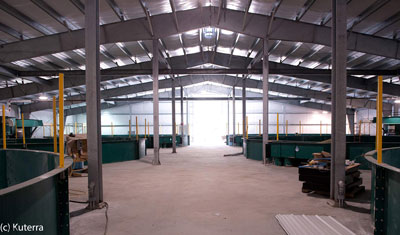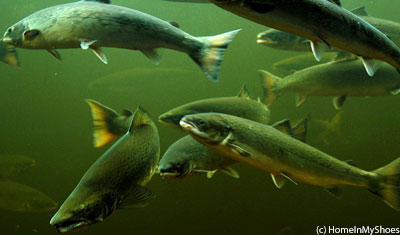
Current methods of Scottish salmon farming tend to use an open net method, which as the name suggests, allows the salmon to mature in natural waters with tidal flows. However, this method comes under criticism due to its proximity to natural ecosystems that can be affected by the fish waste, chemicals and materials that are emitted from these facilities.
As a result, some companies are looking into the possibility of incorporating a closed containment, or land-based, method of farming to limit the immediate impacts on local habitats and communities.
Is land-based salmon farming the future?
Closed containment and specifically land-based Recirculation Aquaculture Systems (RAS) is viewed by many as the only environmentally sustainable and therefore acceptable future for the Scottish salmon farming industry, apart from totally stopping the practice altogether (with little suggestion for alternatives – wild salmon is certainly not the answer[1]). This view is shared by members of the industry itself, with increasing investment and research into closed systems on land and at sea.
In 2016, around 7,000 metric tons of salmon was produced from about 10 projects, and in 2017 analysts from Norway’s largest financial services group, DNB, identified around 150,000 metric tons of land-based production capacity from around 20 projects[2]. However, a submission to the recent inquiry into salmon farming under the Scottish Parliament’s Rural Economy and Connectivity (REC) Committee suggested that actual production in 2017 was less than 5,000 metric tons[3]. The DNB analysis further predicts that if all land-based expansion planned by 2020 materialises, it could rival output from Canada and make land-based production the fourth-largest ‘region’. Most recently a 2018 report by IntraFish identified 28 land-based projects, which could produce about 263,000 metric tons in total, by 2025[4].
The present state of Recirculation Aquaculture Systems technology
RAS technology has developed over the last 30 years for broodstock management, in hatcheries and for salmon smolt production, but progress on its use for growing salmon to adult market size has been restricted. There are several practical issues evident in the use of RAS technology at the moment:
- Start up costs are high (for example, US$ 7.3 million for a Canadian farm);
- Retail prices are higher than for products from open net pens (about double);
- Some are working below capacity due to problems with the RAS equipment, meat quality, cooling and production cycles;
- Many cannot produce adults above 4 kg, when premium farmed salmon can reach 9+ kg[5].
Several of the first commercial RAS were based on experimental research projects producing low numbers and then scaled up for commercial production without adequate engineering[6]. The bigger the RAS facilities get, the more complex and challenging their operation. This can lead to failure by technology providers to include adequate disease control technology in RAS design, or alternatively, aquaculturists may lack the experience to deal with industrial scale flows of farm water that requires purification to a high standard for efficient re-use.
Evidence suggests that it can be done successfully and in an environmentally robust way. Some farms have achieved certification from the Aquaculture Stewardship Council (ASC), generally regarded as the most robust certification for salmon farming from an environmental impact perspective[7], suggesting it could solve many environmental issues.[8].
Should land-based RAS replace open net pens?
 It is early days in terms of land-based production, and some see it as a way for the industry to expand capacity, rather than a replacement for open net farms. While closed containment technology and capacity is being developed, attention must still be paid to improving the current open net method. We must make sure as much as possible is being done to minimise the environmental impacts, and that it is being done in a transparent and easily traceable way.
It is early days in terms of land-based production, and some see it as a way for the industry to expand capacity, rather than a replacement for open net farms. While closed containment technology and capacity is being developed, attention must still be paid to improving the current open net method. We must make sure as much as possible is being done to minimise the environmental impacts, and that it is being done in a transparent and easily traceable way.
Investors are still cautious about closed containment as there is a lack of companies with a record of constant/consistent operation and a history to refer to, alongside a substantial record of company failures in the UK, Europe and internationally.
However, investment is continuing. Asia and China in particular are growing markets for Atlantic salmon, with China’s expected annual market to be 250,000 tonnes by 2024. RAS is attractive to China because it reduces airfreight costs and enables ‘made in China’ marketing A number of large-scale projects are also underway in the US, with predictions by producers that costs could be almost half of Norwegian produced salmon. However, these are physically located close to markets, giving them a freight advantage over Scotland’s markets. While the risks associated with land-based salmon farming may appear to be declining, Scotland may not have sufficient resources to successfully embrace it, such as inexpensive power sources[9].
To replicate the tonnage presently produced in Scotland, the required investment in RAS has been estimated as £1.4bn to £1.7bn. The distance to the main salmon markets and high logistical and energy costs suggests Scotland is unlikely to be a competitive location for land-based RAS for growing salmon to adult size, with developments closer to market more likely. High market prices would make it viable, however these would be vulnerable to the success of other farming strategies such as offshore operations and closed containment at sea. While premium pricing is achievable at the moment for RAS-produced fish it may be a niche market of only a few thousand tonnes each year. It’s therefore unsure whether a robust business case for investing over £1bn to move Scottish salmon to land can be made.
Other closed containment developments.
There are developments in Norway and Canada for floating closed-containment systems with flow through treated water technology that may prove to be a more realistic alternative to land-based RAS[10],[11],[12].
These systems are designed to keep sea lice, predators and pathogens out and fish securely in. Solid wastes can be collected for distribution over a controlled sea area depending on environmental assimilation capacity, or removed for treatment elsewhere.
This technology has the potential to provide Scottish salmon farming with a scenario that works for both farming and environment, and merits close monitoring if salmon is going to continue to be a staple food on our shop shelves.
[1] https://www.scotsman.com/news/environment/last-scottish-wild-salmon-facility-closes-as-there-are-so-few-fish-to-catch-1-4838157
[2] http://dyneaquaculture.com/wp-content/uploads/2017/05/DNB-Markets-Deep-dive-into-land-based-farming.pdf
[3] http://www.parliament.scot/S5_Rural/Douglas_Low.pdf
[4] Intrafish (2018) Land-based salmon farming: Aquaculture’s new reality. An IntraFish Industry Report. Edited by Fischer, E. pp 40.
[5] http://www.ocean-supreme.com/products/whole-atlantic-salmon
[6] https://dspace.stir.ac.uk/bitstream/1893/21109/1/HIE_RAS_Study_Final_Updated.pdf
[7] http://jurassicsalmon.pl/en/
[8] http://jurassicsalmon.pl/en/
[9] https://www.intrafish.com/aquaculture/1648165/aquaculture-innovation-2018-are-risks-for-closed-cage-land-based-salmon-farming-declining
[10] https://www.cermaq.com/wps/wcm/connect/cermaq/news/mynewsdesk-press-release-2254335/
[11] https://www.fishfarmingexpert.com/article/marine-harvest-ready-to-hatch-egg-by-2019/
Tags: closed containment, land-based, RAS, salmon, Scottish

